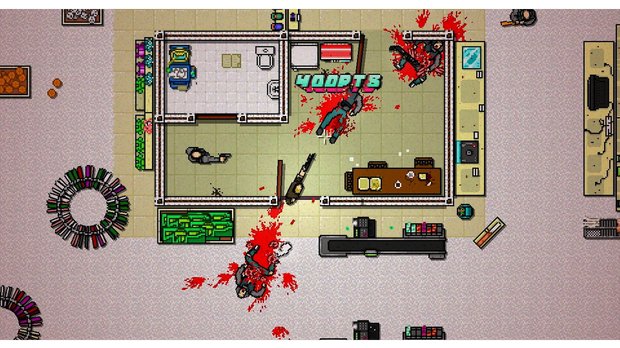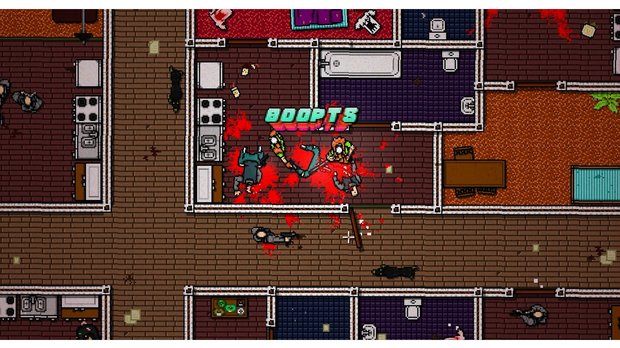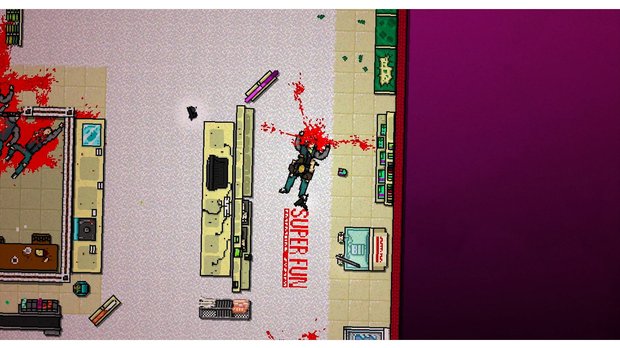Why Hotline Miami 2's Australian 'ban' is as worrying as it is confusing
Last week, very briefly, I was rather worried about Hotline Miami 2: Wrong Number. I read, like many did, a story about the game having been effectively banned in Australia. Initially, I didn’t bat an eyelid. Australia has long drawn one of the hardest of lines when it comes to video game violence, and the original Hotline Miami is a very violent game indeed. A very intelligent, cannily designed, deceptively insightful one, mind, but one which paints its questions and answers with the pixelated entrails of several thousand anonymous goon-men. Naturally, I assumed that this was simple, half-expected case of more of the same, like Germany not liking the last Wolfenstein, or John Carmack not caring and making the new Doom even more brutal than ever.

But then I read the Kotaku's quoted text from the Australian ratings board’s report. And it was kind of worrying. While not 100% literally banned, the game had been refused even the country’s adults-only rating. The reasons given for that?
“In the sequence of game play footage titled Midnight Animal, the protagonist character bursts into what appears to be a movie set and explicitly kills 4 people, who collapse to the floor in a pool of copious blood, often accompanied by blood splatter. After stomping on the head of a fifth male character, he strikes a female character wearing red underwear. She is knocked to the floor and is viewed lying face down in a pool of copious blood. The male character is viewed with his pants halfway down, partially exposing his buttocks. He is viewed pinning the female down by the arms and lying on top of her thrusting, implicitly raping her (either rear entry or anally) while her legs are viewed kicking as she struggles beneath him. This visual depiction of implied sexual violence is emphasised by it being mid-screen, with a red backdrop pulsating and the remainder of the screen being surrounded by black.”
Now I had a perturbed eyebrow raised. Let’s face it, the wording there makes the scene sound horrific. Murderous rampages through buildings full of mooks, we’ve come to expect from Hotline Miami, but rounding it all off with a gratuitous rape initiated by the player character? Even after putting dozens of hours into finishing the first game, I really wasn’t sure I was okay with that. In fact I was pretty sure I wasn’t. This was definitely way over my personal line, and immediately I worried that Dennaton, HM’s developer, had lost the run of itself somewhere between the acceptance of the originals work’s violence and the game’s ultimate, critically lauded success. And that made me very sad indeed, because the first Hotline is as intelligent with its treatment of violence as it is graphic.

So it was with a fair old degree of trepidation that I clicked the play button on the video footage of the offending scene that I subsequently found. Fortunately, a minute or so later, my reaction was not sadness or disappointment, but rather a great deal of relief, tinged with a little guilt that I’d been so negative about something without knowing the facts.
Well. I say there was no sadness or disappointment. There quickly followed rather a lot of it. But none of it was aimed at Hotline Miami 2.
You see, however I spin it, however I try to interpret its words through the imagined values of someone who isn’t me, there’s just no way that the above description of the scene’s content is accurate. Not at all. Not factually, and just as importantly, not in relation to the vitally important matters of context, purpose and meaning that responsible, influential media criticism should be primarily concerned with.
Sign up to the GamesRadar+ Newsletter
Weekly digests, tales from the communities you love, and more
You can watch the video for yourself below, if you choose to, but the nutshell version is thus. The scene opens with the title card of a fictional film company. As soon as the playable action starts, credits appear on the screen, clearly emulating the opening of a movie. It’s immediately obvious that not only are we on a film set, but that we’re actually playing a film within a game, a scene set one level of reality apart from the game’s own fictional world.
By the time the ‘rape’ happens – in a way similar to, but slightly less graphic than, the partially fabricated account in the Australian report – it’s pretty clear that there’s something more than gratuitous violence going on. And as the ‘level’ ends? As I expected by this point, the instructional voice in the protagonist’s ear is revealed to be not a collusive colleague in crime, but a previously unseen film director, who calls ‘Cut!’ on the scene, and sends everybody off. None of what we’ve seen really happened. It’s a simulation within a simulation.
Surprise. Things were not as you thought. Your assumptions were subverted. The game knew what you expected, coming off the back of its precursor, and it played with those expectations, pushing – almost parodying – them in its escalation, before pulling the rug out from under you. There’s context here. There’s purpose and there’s meaning. As dark as the tools it uses may be, in terms of conceptual direction, the scene is a smart, self-aware, highly effective opening that seems intent not to shock or exploit, but to start a dialogue with its audience about its relationship with content that does. In short, it’s exactly what I had expected from Dennaton, before I read of the Australian decision.
But you won’t get any of that from the official statement. While the film set environment is acknowledged, any reference to the reason for the setting is conspicuous by its absence, a omission that feels flat-out illogical. The description of the scene’s crescendo omits both its true context and any mention of the two different versions available - both in the video above - and replaces them with some imagined thrusting that apparently only the censor saw.

Two versions? Yes, the game is aware of individual taste preferences, and offers to self-censor in sympathy to that. But the report doesn’t mention that, just as it doesn’t mention the pay-off, the twist, the real point of this entire scene. It doesn’t reference the event that utterly changes the meaning of what we’re seeing. Instead, it plays the events straight, with zero nuance or insight, just as I’d feared the game might before I saw it.
It seems to me, at this point at least, that what we have in Hotline Miami 2’s introductory scene – with its depiction of gratuitous in-world fiction – is not a simple lurid escalation of the series own violence, but the start of a discussion about lurid escalation of media violence. Let us not forget that the first game tempers its brutality throughout, structuring its levels, and even its narrative structure, to force frequent, sobering acceptance of its aftermath.
Indeed, staying with the first game, if you’ll indulge me in a brief flight of extrapolated thought and guesswork, it’s worth noting that the scene has a slight parallel with a level in the original game, in which the protagonist ultimately rescues – but does not assault – an abused prostitute from the enemy. With the sequel set years afterward, there’s every chance the movie being made is actually an exaggerated, exploitative adaptation of the first game’s events. The scene the director describes as being next to film certainly ties in with what followed in the original Hotline.

I’m on a tangent here, admittedly. But regardless, I can’t help viewing the footage in question as a game playing with the idea of mindless excess, but not necessarily exhibiting it. And if Hotline Miami 2 is indeed baiting a trap of audience expectation and assumption, it seems that the Australian ratings board has alas stumbled into it. I can't tell you how or why. I’m bamboozled that a board that has passed films as brutal and debatably worthy as Hostel, Wolf Creek and Irreversible has refused classification of a game that so far seems at least purposeful in the extremity of its subject matter. Maybe someone missed the point. Maybe games still aren’t viewed as the equal medium we like to think they are. I don’t know.
And another thing I don't know is what the rest of the game is like. I'm working on isolated scenes and knowledge of the first game here, so of course I'm extrapolating. And of course there's a chance that there will be things in the final, complete product that I'll have a problem with. There are a million ways any creative work using extreme content can get things tonally right or wrong, and some of what the game does will - on some level - almost certainly offend some of those who choose to view it. But what I do know is that that I’m going to be reviewing Hotline Miami 2 when it comes out, and that however smart, thoughtful, exploitative or base its ultimate, complete form may be, I’ll bring you a full, honest discussion of it all. I’m just thankful that, being an intelligent, critical, media-literate adult in the UK, I’ll – hopefully – be allowed to.



